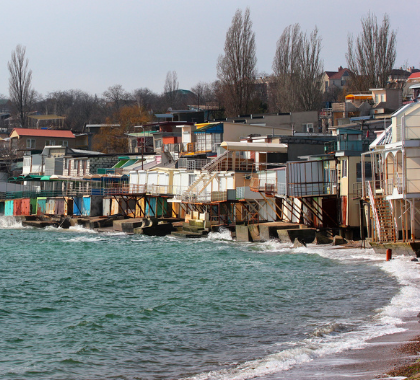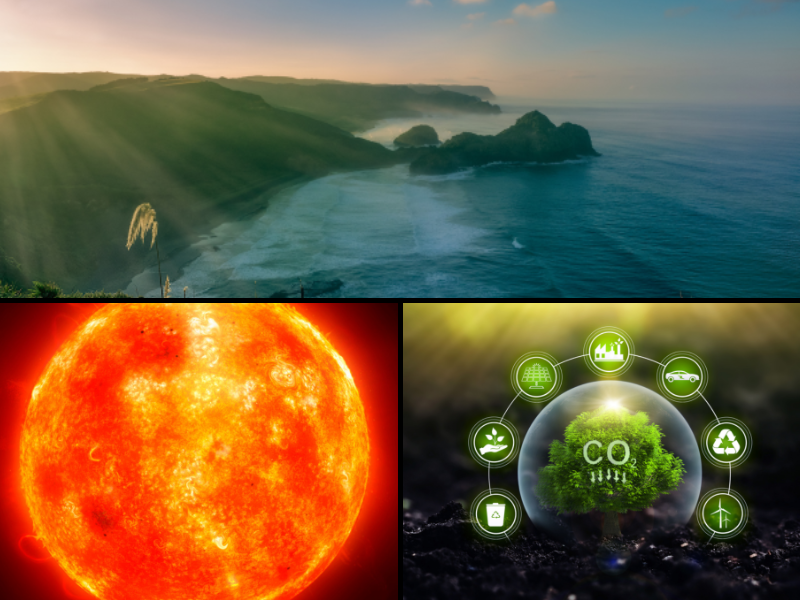Environmental activists, mainstream media outlets, and many scientists routinely claim governments must take drastic action to transform the world’s economic system, including ending the use of fossil fuels, or island nations will disappear beneath the seas and low-lying coastal cities will be swamped, forcing a great migration of populations inland.
To back up their claims, they cite statements from the Intergovernmental Panel on Climate Change (IPCC) asserting it is “very likely” sea level rise has accelerated since the middle of the twentieth century in response to warming caused by rising greenhouse gas emissions. The IPCC, however, bases its claim on computer model projections instead of measured, real-life data.
Data lend little support to the claim seas are rising at a historically unusual or increasingly rapid rate. Global sea levels have risen by approximately 400 feet since the beginning of the end of the most recent ice age (approximately 20,000 years ago), with the sea level rise slowing and increasing over periods of tens, hundreds, and thousands of years over the past 20,000 years, having nothing whatsoever to do with human activities.
Research shows most of the islands making up nations such as Tuvalu and the Maldives are gaining land and mass, not losing it. A peer-reviewed study that examined 600 coral reef islands in the Pacific and Indian Oceans reported approximately 40 percent of those islands remained stable and 40 percent grew. More evidence they and coastal areas in Florida and Hawaii, for instance, aren’t sinking beneath the waves can be inferred from the fact that the populations on these island nations and the coastal United States are increasing instead of fleeing, and they are putting up new, expensive buildings and associated infrastructure daily.
A 2019 report by Drs. Craig Idso, David Legates, and the late S. Fred Singer confirms sea levels have not been rising at an unusual rate in recent years. After examining long-term data from tidal gauges and other sources, Idso, Legates, and Singer write, “the highest quality coastal tide gauges from around the world show no evidence of acceleration since the 1920s.”
The difference between data recorded by the global tidal gauge system and projections made by various purported climate authorities is because “[l]ike ice melting, sea-level rise is a research area that has recently come to be dominated by computer models,” the authors write. “Whereas researchers working with datasets built from long-term coastal tide gauges typically report a slow linear rate of sea-level rise, computer modelers assume a significant anthropogenic forcing and tune their models to find or predict an acceleration of the rate of rise.”
Human actions, such as the construction of barriers, channeling of rivers, conversion of coastal wetlands into densely populated metropolitan areas, and draining of coastal aquifers for human consumption (which causes land subsidence) have undoubtedly made some coastal regions and populations more vulnerable to rising seas. Nonetheless, there is little evidence increased greenhouse gas emissions are contributing to ocean rise.
In a 2017 Heartland Institute study, geophysicist Dennis Hedke analyzed data from 10 coastal cities with relatively long and reliable sea-level records and found there was no correlation between changes in sea levels at these locations and rising carbon dioxide levels.
For some cities, the rate of sea level rise has remained virtually constant, neither increasing nor declining appreciably from the rates experienced before humans began adding substantial amounts of greenhouse gases to the atmosphere. Other cities, such as Ceuta, Spain, have experienced very little sea level rise over the past century, exhibiting almost a flat trend line well below the historic rate of global sea level rise of approximately seven inches per century. Other cities, such as Sitka, Alaska, have experienced falling sea levels. Still others, such as Atlantic City, New Jersey, have experienced a large, rapid increase in sea levels.
The point is different areas around the world are having different experiences with sea levels, with differences in the rate of sea level rise being a result of localized conditions, not global climate change.
Some alarmists have recently tried to respond to observation that claims of accelerating rates of sea level rise are based on computer models alone, not hard data, by citing satellite-reported sea-level data collected by University of Colorado researchers. Their dataset indicates seas are rising by approximately 3.3 mm per year, much higher than the annual rise of approximately one to two mm recorded at tidal stations, a rate that has changed little over the century or so for which we have adequate records.
The rate of rise claimed by the University of Colorado researchers is a result of statistical sleight of hand, produced by mixing data from four different satellites: combining data from two earlier satellites and two later satellites that record significantly higher rates of sea-level rise than the earlier two satellites. As meteorologist Anthony Watts points out, the earlier dataset shows a much smaller trend of sea level rise than the latter two satellites:
Neither set of the satellite record shows any accelerating trend. The UC scientists simply combined the two dissimilar data sets, plotted a new trend showing acceleration, and didn’t mention the difference.
This is either incompetent or dishonest, and certainly not up to even the simplest of basic science principles. Virtually any high school or college student who presented such work for a class would get called out on it by their instructor for showing a false trend.
Our knowledge of previous interglacial cycles indicates seas will continue rising unless and until the next ice age comes, notwithstanding any efforts humanity may make to stem the tides.
It makes sense to prepare for rising seas by hardening coastal areas, discouraging ill-advised coastal development, and making people living along coasts aware investments made there could be swallowed by rising water. Ending the use of fossil fuels and giving ever-larger governments increasing power over peoples’ lives will not stop the seas from rising and will only make people poorer and less free.
— H. Sterling Burnett
SOURCES: The Heartland Institute; Intergovernmental Panel on Climate Change; The Heartland Institute; Climate Realism; Climate Realism
IN THIS ISSUE …
FLAT CYCLONE TREND MEASURED NEAR JAPAN, DECREASE NEAR HONG KONG … SOLAR INFLUENCE ON CLIMATE CHANGE CONFIRMED … HUMANS NOT CAUSING EXTREME WEATHER, SAYS STUDY
FLAT CYCLONE TREND MEASURED NEAR JAPAN, DECREASE NEAR HONG KONG
Two papers in an edition of the peer-reviewed journal Climatic Change examining “historical and recent change in extreme climate over East Asia” find tropical cyclones (TCs) have become neither measurably more powerful nor more frequent over Japan and the parts of China under review.
A study by a team of researchers from various universities and research institutes in China collated and analyzed three different datasets: instrumental surface air pressure (SAP) records from 1885 to 2017 measured at the Hong Kong (HK) station, SAP data spanning 1951 to 2016 at 66 stations over mainland China, and modern TC numbers for 1951-2017 from the Best Tracks dataset covering the Northwest Pacific. After assembling, analyzing, and comparing the three datasets, the researchers determined the strength and number of tropical cyclones that struck Hong Kong and the surrounding region declined between 1885 and 2017, with an “obvious reduction occurring after the early 1960s. Specifically, the 10 years of 1994-2003 had the smallest number of TCs.”
The second paper, with contributions from scientists at universities and research institutes in Japan, the United Kingdom, and the United States, examined data assembled from ships sailing through the region before consistent freestanding weather stations were established, and data from lighthouses and weather stations (after they were established) to measure TC strikes on Japan and the region.
The team found no consistent trend in the number of TCs striking Japan. They did find from the 1970s to the 2000s the number of landfalling TCs was lower than at other times, including the 1800s. Upon developing an estimated annual power dissipation index (APDI) to measure hurricane intensity from mid-1800s through 2019, the researchers observed “High APDI periods are found … around 1900, in the 1910s, from the 1930s to 1960s, and after the 1990s.” They also found TCs seem to shift northeastward to southwestward and back at 100-year intervals.
SOURCES: Climate Change; Climate Change
SOLAR INFLUENCE ON CLIMATE CHANGE CONFIRMED
Science has long acknowledged the Sun provides the energy required to sustain life on Earth and drive our planet’s atmospheric circulation, yet climate alarmists claim any connection between solar cycles and large-scale, decadal changes in the Earth’s climate is small. New research published in the journal Earth and Space Science, however, indicates a connection between the approximately 11-year cycle of sunspot activity and an underlying 22-year cycle of shifts in the Sun’s magnetic polarity to “the Sun’s radiative output and particulate shielding of our atmosphere through the rapid global reconfiguration of solar magnetism.” These changes correlate strongly with shifts from El Niño to La Niña cycles of the Pacific Ocean, which produce large effects on ocean temperatures, sea life, and weather patterns, the scientists found.
In particular, the team of researchers from universities and research institutes in the United States and the United Kingdom used “direct observation and proxies of solar activity going back some six decades, with high statistical significance, [to] demonstrate a correlation between the occurrence of terminators and the largest swings of Earth’s oceanic indices: the transition states of the central Pacific.”
These findings, if confirmed, have importance both for an accurate understanding of climate change in general and in anticipating when large-scale El Niño to La Niña oceanic shifts occur. The latter significantly “impacts lives, property, and economic activity around the globe,” the researchers note.
The effect of shifts in the Sun’s magnetic polarity is yet another factor climate models fail to account for when making projections about the direction, magnitude, and impacts of climate change.
SOURCES: Global Warming Policy Foundation; Earth and Space Science
HUMANS NOT CAUSING EXTREME WEATHER, SAYS STUDY
A new research paper from the Global Warming Policy Foundation (GWPF) shows attempts to blame extreme weather on human-caused global warming are “overconfident and probably wrong.”
In the paper, statistician and philosopher of science William M. Briggs, Ph.D. shows most claims attributing specific extreme weather events and trends in extreme weather and temperatures are made by researchers comparing computer simulations of the climate today to simulations of the climate as it might have been without human activity. The problem with such claims is the simulations are only as good as the assumptions built into the models and our understanding of the full panoply of factors that influence climate and how they interact.
“We simply have little or no idea what the climate would have been without human activity,” Briggs told the GWPF. “Moreover, we can’t ever know what it was like.
“In order to attribute individual weather events to humankind, scientists need a perfect model of the climate. They do not have this. Therefore, claims that we are responsible for any particular weather event are at best overconfident, if not plain wrong,” Briggs says.
Attribution studies assume the weather has been getting worse, yet empirical observations refute this claim, Briggs notes.
“These studies assume either (a) perfect forecasting models, or (b) known, uncertainty-free causes of climate change,” Briggs writes. “Neither condition holds. Because of this, attribution claims are far too certain or are wrong. They should not be used in any policy decisions.”
SOURCE: Global Warming Policy Foundation





